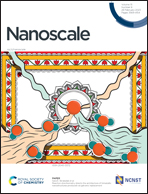Magnetic nanocomposites for magneto-promoted osteogenesis: from simulation auxiliary design to experimental validation†
Abstract
Magnetically actuated mechanical stimulation, as a novel form of intelligent responsive force stimulation, has a great potential for remote spatiotemporal regulation of a variety of life processes. Hence, the optimal design of magnetic nanomaterials for generating magneto-mechanical stimuli becomes an important driving force in the development of magneto-controlled biotherapy. This study aims to clarify the general rule that the surface modification amount of magnetic nanoparticles (NPs) affects the biological behavior (e.g., cell adhesion, proliferation and differentiation) of pre-osteoblast cells. First of all, course-grained molecular dynamics simulations predict that 23.3% graft modification of the NPs can maximize the heterogeneity of the dynamics of the polymer matrix, which may generate enhanced mechanical stimuli. Then, experimentally, iron oxide (IO) NPs grafted with different amounts of poly(γ-benzyl-L-glutamate) (PBLG) were prepared to obtain homogeneous magnetic nanocomposites with improved mechanical properties. Further in vitro cell experiments demonstrate that the grafting amounts of 21.46% and 32.34% of PBLG on IO NPs are the most beneficial for the adhesion and osteogenic differentiation of cells. Simultaneously, the maximized upregulation of the Piezo1 gene indicates that the cells receive the strongest magneto-mechanical stimuli. The consistent conclusion of the experiments and simulations indicates that 20–30% PBLG grafted on the IO surface could maximize the ability of magnetic stimuli to regulate the biological behavior of the cells, which validates the feasibility of simulation auxiliary material design and is of great importance for promoting the application of magneto-controlled biotherapy in bioengineering and biomedicine.



 Please wait while we load your content...
Please wait while we load your content...